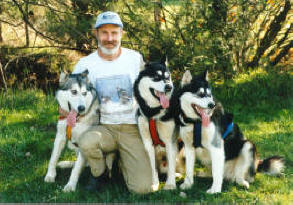|
 Understanding
the Alaskan Malamute Understanding
the Alaskan Malamute
 Temperament
Temperament
 Instincts
Instincts
 Maintenance
Maintenance
The
Malamute is an arctic sledding breed that originated in the Kotzebue Sound
area of Alaska with the Inuit Eskimo tribes. The breed is thousands of
years old.
The
Malamutes were highly prized by the Eskimos and were a necessity for their
survival. They were used as a working animal that was required to pull
moderately heavy loads for long distances at a steady pace. This is in
contrast to their cousin from across the Behring Strait, the Siberian
Husky, which is a smaller, finer-boned dog used to pull lighter loads for
shorter distances at a quicker pace. Although
the Malamute is thought by some to resemble the wolf, there is no evidence that
they are any more closely related to the wolf than a Poodle, Chihuahua, Basset
Hound or any other breed of domestic dog.
The
Malamute and wolf both developed in the same arctic environment which is
the reason there are many similarities in physical attributes and
appearance, particularly those characteristics such as coat and
structure which are integral to arctic survival. The
temperaments towards humans, however, are vastly different between the
wolf and Malamute. The Malamute will happily cohabitate with
humans and consider them with respect, while the wolf will consider the
human simply as prospective prey!
 To
understand the Malamute mind you need to acknowledge and understand its origins
as a hunting and working dog of the arctic regions. Many of the instincts which
allowed the Malamute to survive in the harsh Alaskan environment are well
embedded and remain extremely strong in the breed today, despite their many
years now as backyard pets. To
understand the Malamute mind you need to acknowledge and understand its origins
as a hunting and working dog of the arctic regions. Many of the instincts which
allowed the Malamute to survive in the harsh Alaskan environment are well
embedded and remain extremely strong in the breed today, despite their many
years now as backyard pets.
For this reason any
prospective Malamute owner needs to do their homework about the
breed and be aware that the pet Malamute will still have a strong
urge to hunt other animals (sometimes including smaller pets), dig,
roam over huge distances, be stubborn and a challenge to train, and
often will be prepared to fight another dog over food. The
Malamute is not the ideal breed as a family pet, for the first dog
owner or for those who are not prepared to take on the role of pack
leader.
Author: Sandy Koch, Windchill Kennels.
|